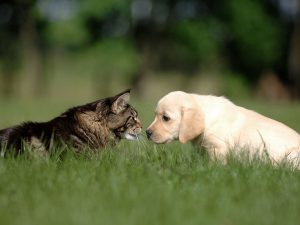Introducing your puppy to other pets:
Congratulations on the adoption of your new dog! Bringing home a new dog is a very fun and exciting experience for all family members. It can be especially exciting for your resident dog to have a new canine companion! It is our responsibility to facilitate positive and rewarding introductions between our canine family members to help them form a healthy relationship and feel comfortable with each other. Animals that live in groups, like dogs, establish relationships, through which the individuals involved interact and live together. The roles that the individuals play within the relationship can change with each new day or situation.
Dog to dog introductions:
Neutral, safe location
- All introductions should initially take place in a neutral location – a place that is not familiar to either dog. A fenced-in outdoor space is best, if possible.
Greeting
Before you begin the greeting process, make sure all dogs are on a standard six-foot leash and a flat collar or harness. There should be one person/handler per leashed dog. Each handler should have a pocket full of high-value treats (chicken, steak, cheese, etc.).
Start the introduction with a series of parallel walks:
- Walk each dog in the same direction with approximately 10 to 20 feet between them. When the dogs look at each other, reward the dogs with a few treats. If the dogs are showing signs of discomfort, continue to feed both dogs and increase the distance between them.
- During the walk, gradually decrease the space between the dogs if they appear comfortable, and continue to offer them treats.
- Once the dogs are comfortable being close (about five feet) to each other, allow one dog to walk behind the other, and then switch.
Next, walk the dogs side by side:
- Allow the dogs to sniff each other. Pay close attention to the dogs’ body language and if needed, distract the dogs by getting their attention with your voice, treats or a squeaky toy.
- If all goes well with sniffing and on-leash interaction, take the dogs to an enclosed area, drop their leashes and give the dogs some space to get to know each other. Be prepared with voice, treats, and squeaker toys to redirect the dogs’ attention back to you if needed.
- Be careful when feeding treats to multiple off-leash dogs.
- Each handler should continue to feed the dogs separately to avoid competition over food.
During the leashed greeting portion of the introduction process:
- Keep a loose leash! Tightened leashes can increase tension on the collar and cause discomfort or stress.
- Keep moving! Be ready to move around with the dogs to avoid the leashes becoming tangled.
- Stay calm! Avoid shouting and offer dogs verbal praise.
Body language
It is very important to pay close attention to the dogs’ body language during introductions. Signs that indicate a dog is worried or not comfortable with the interaction include:
- Growling
- Hair standing up
- Baring teeth
- Stiff body
- Prolonged staring
- Avoidance/hiding
- Ears pinned back
- A tucked tail
When to STOP the introduction
- If either dog starts displaying any of the above behaviors, interrupt the interaction by getting the dogs’ attention with voice, treats or squeaky toys.
- Increase the distance between the dogs and begin again. In addition to closely watching the dogs’ body language, you will need to closely watch how the dogs read each other’s body language signals.
- If one dog is giving clear signals of feeling uncomfortable, and the other dog is not responding appropriately (i.e. moving away and/or stopping interaction), you should intervene and redirect the dog’s attention.
At home
- Once home, continue to closely watch and supervise all interactions. If you are unable to closely supervise the dogs, keep them separated.
- Feed dogs separately to avoid competition over food.
- Provide several comfortable resting places and lots of quiet time.
- Spend time with each dog as an individual.
- Keep your resident dog’s routine consistent.
- Only give toys and rawhides while watching/supervising the dogs, or when the dogs are separated.
